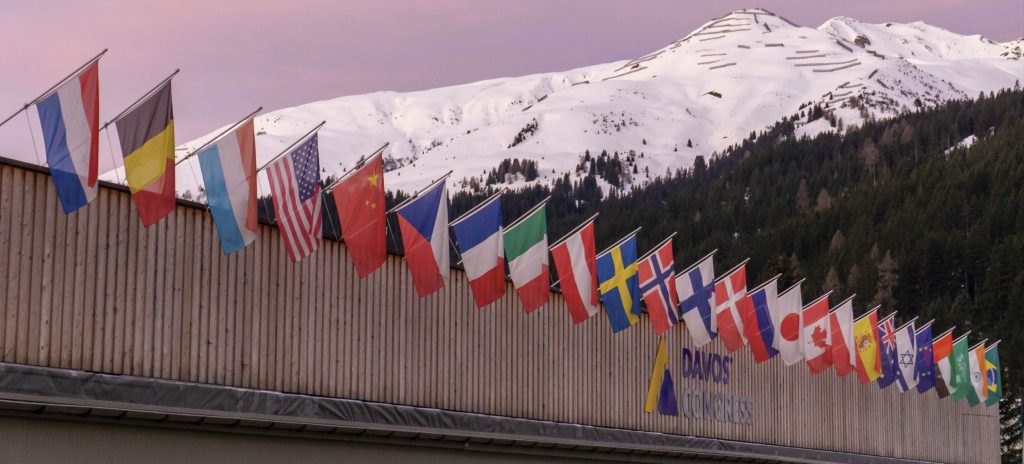
Davos 2024: ‘Rebuilding Trust’ one performative oat flat white at a time
As decision makers gather at the annual World Economic Forum’s meeting in Davos, there are questions being asked about the value of the event to address climate change. Rislilience Climate Policy Lead, Andy Garraway, considers the challenges and brings balance to expectations.
For those looking for their caffeine fix at the World Economic Forum’s annual meeting in Davos this week, it is a choice of oat, almond or soy milk – all in the name of sustainability, of course. Our, admittedly simplistic and entirely illustrative, back-of-the-envelope calculations show that, by making this simple switch at the conference centre cafe, Davos’ 2,500 attendees will save nine tonnes of carbon dioxide equivalent (tCO2e ) over the course of the week when compared to having their daily flat whites frothed with dairy[1]. Could this switch mark a step towards ‘Rebuilding Trust’, to chime with this year’s summit theme? Possibly, until you realise that the nine tCO2e saved on dairy milk pales in comparison with the estimated 7,275 tCO2e emitted by private jets flying in attendees to the summit last year, and no doubt repeated this year[2].
Will Davos result in anything positive for the climate crisis to justify those private-jet emissions? If you’re waiting to hear a big announcement from a global corporate or national leader, chances are you’ll be disappointed: climate’s barely on the agenda this year. But take a step back and see Davos for what it is – a talking shop of policymakers and business leaders – and it becomes clearer that it has a role to play.
This year is going to be a difficult one for climate diplomacy and climate action. A number of geopolitical flashpoints around the globe are leading to an increasingly polarised world: anathema to a global crisis causing impacts around the world and which requires a globally-coordinated response. The coming twelve months mark the biggest election year in history, with 64 countries and the EU going to the polls. In a number of these jurisdictions, including the US and the UK, climate policy is either already, or fast becoming, politically contentious with potential for disjointed and inconsistent policymaking at a time when only six years remain to halve global emissions, which are still increasing.
On the global stage, both the US’ and China’s top climate diplomats are stepping down, which risks jeopardising how the two most important countries in the fight against climate change will work together.
We are living in a world that faces many risks, as acknowledged by the World Economic Forum in its suite of annual reports covering global risks, energy demand and global cooperation. Five of the top ten severe long-term risks are environmental, with a number of other top-ranked risks, including involuntary migration and societal polarisation, driven or exacerbated by the climate crisis. A new entrant to this undesirable chart is ‘critical changes to Earth systems’, which are environmental tipping points where the capacity of vital climactic systems to keep going in the face of ever-increasing temperatures collapses, with devastating, irreversible and escalating consequences. Despite all of these issues being viewed as ‘long-term’, there is at least a realisation that things are getting worse and what was once considered ‘long-term’ is starting to impact, now.
So, what can Davos do to help? One positive conclusion to emerge from the Global Cooperation Barometer is that levels of cooperation on climate and nature have been rising steadily, in large part driven by countries and companies increasing their commitments to take action. While this hasn’t yet led to a fall in emissions, a number of commentators are predicting that 2024 might just be the year in which the seemingly inexorable rise in emissions finally comes to an end.
And that’s where Davos comes in. It is where world and business leaders talk to one another and agree what needs to be done. Coming hot on the heels of COP28, Davos offers an opportunity for these decision makers to meet, in large part away from the prying eyes of the media, and have those difficult one-on-one discussions about how to put the goals of COP28 into practice. Don’t expect to get a breaking news alert on your phone about the Davos agreement to counter climate change. That said, we shouldn’t totally write off the value in decision makers getting together behind closed doors to knock heads.
- Watch the Risilience ‘COP28: navigating the regulatory landscape as a business in 2024’ webinar on demand
[1] We assumed each of the 2,500 attendees would consume two flat whites per day over fivedays equating to 25,000 coffees, with each flat white requiring 160ml of milk equating to 4,000 litres of milk in total. We used Joseph Poore and Thomas Nemecek’s 2018 study that dairy milk emits 3.15kg CO2e per litre and oat milk 0.9kg CO2e per litre.
[2] Using CE Delft’s figures of 9,700tCO2e caused by private jets during the 2022 WEF and their calculation that emissions quadrupled during the one week of the meeting, we baselined private jet emissions at around 2,425t per week to and from airports serving Davos. This figure of 2,425t was subtracted from the total of 9,700t to account for
baseline private jet usage which might not be linked to the summit.